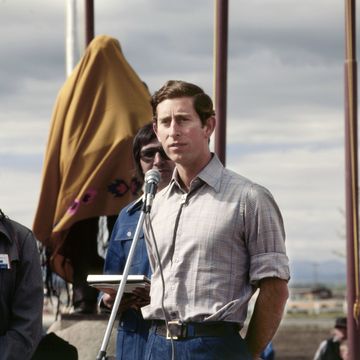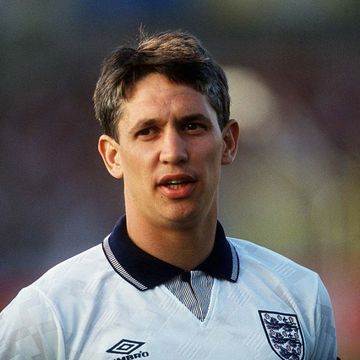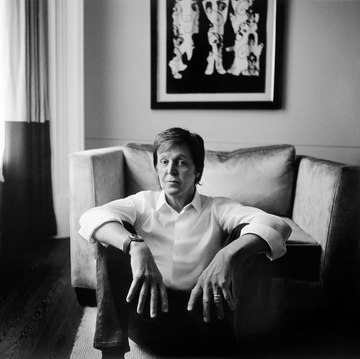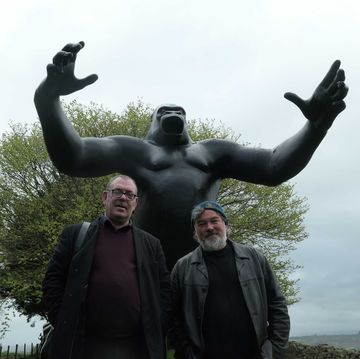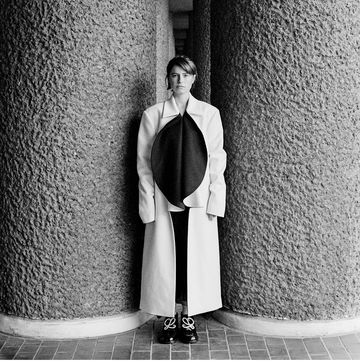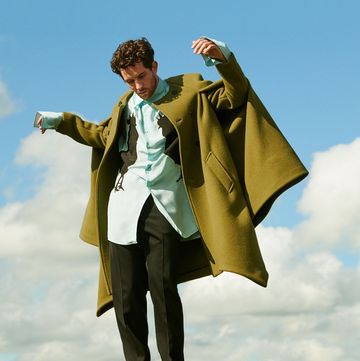There's a thing that sometimes happens when Eddie Redmayne gets the tube. He'll be sitting there, keeping himself to himself, and as usual everyone around him will be absorbed on their mobiles. Then he'll notice in his peripheral vision that the person opposite him has started lifting their phone, slowly, until it reaches a height that is suspiciously unconducive to playing Candy Crush Saga. Then the flash goes off. Redmayne looks up; the other person looks back. "And you just have this really awkward 37 seconds before you run off the train in embarrassment," says Redmayne. "'You're like, 'Oh, I get it. But couldn't you have asked?' Of course, people go, 'That's what you've signed up for.' Maybe they're right."
Yes, Eddie Redmayne, the 34-year-old British actor and Nicest Man in the Business, still takes the tube. It's one of those clichéd questions, like the price of a pint of milk, that journalists use to assess how far from humdrum normality a star has risen (or should that be spiralled?). I wasn't even allowed to ask Roger Federer. Redmayne seems slightly taken aback by it: "Absolutely. It's really not a problem at all. How else do you get around London? I mean, in the sense that the traffic is so awful." Only Redmayne, as we'll get to later, is also now a 34-year-old British actor who can get around London by helicopter: another handy way of avoiding those jams.
It's early autumn when we meet, in a restaurant in Marylebone, central London, that is kitted out to resemble a turn-of-the-century Viennese café, complete with dark wood panelling, mounted animal heads and glum landscapes on the walls. The maître d', when I ask about the reservation, gives me a surreptitious wink before showing me to a booth in the front window. Redmayne arrives a minute or two later on foot (you know, as opposed to horseback, or sedan chair), in jeans, trainers and a woolly jumper with a rucksack over his shoulder. He has tousled hair with some grey at the temples, eyes that actually twinkle, and that dramatic slash of a mouth that on screen can make him look delicate and pretty — or even, when he wants to, a little freaky — but in person is boyish and handsome. It's all decidedly low-key.
Eddie and his wife, Hannah, and their new baby Iris, who was born in June, have been renting a cottage in the Midlands for the past few months, partly as a retreat from London, partly to be close to Hannah's family. She has just dropped him off round the corner, before heading back to their usual home: a flat in Bermondsey. Or she'll try to anyway — as Redmayne was about to get out of the car, they realised that neither of them had brought their keys. "We had a complete catastrophe five minutes before coming here," he says. "We've got to try and go to the person who lives in the flat above… It's so frickin' stupid." We've all been there.
Where we haven't been — and apologies if I'm making assumptions here — is up on stage at the Oscars, to collect the 2015 award for best actor from Cate Blanchett for portraying the theoretical physicist, cosmologist and motor neurone disease sufferer Professor Stephen Hawking in James Marsh's The Theory of Everything. And we haven't sat in the Dolby Theatre in Los Angeles again this year, after being nominated for the same award for playing Lili Elbe, one of the first people to undergo gender reassignment surgery, in Tom Hooper's The Danish Girl (and we were not the first nominee on our feet applauding when it went instead to Leonardo DiCaprio for The Revenant). Nor did we go for several months of this year to Leavesden Studios in Hertfordshire, which was transformed into New York in the Twenties, to play a magizoologist with a suitcase full of supernatural critters in what is destined to be one of the box office-obliterating movies of the year: Fantastic Beasts and Where to Find Them. Because Redmayne, for all his carefully preserved normality, is leading a life that is really anything but.
He did, to be fair, have an auspicious start. He was raised in Chelsea, the middle of three brothers, with an older half-sister and half-brother from his father's previous marriage. His father, Richard, is in finance and has been described as a "City legend"; his mother Patricia, formerly a "relocation" specialist ("I can tell you what that is if you want!"), no longer works. He attended Eton and then Cambridge, where he studied History of Art at Trinity College. The Mail Online likes to run stories about him with headlines such as, "How Eddie Redmayne went from riches to riches" or, "The Oscar for outstanding poshness goes to..." etc. His background is, says Redmayne, a particularly British point of focus. In Hollywood they get over it sooner. "Usually it's the quick question, 'Oh my God, you went to school with Prince William?' That's it."
Much like his Royal schoolmate, Redmayne is something of a model Englishman: just the sort of impeccably decent fellow you'd want to represent us in front of the rampant Hollywood hordes. Unspeakably polite, impossibly self-effacing, and yes, delightfully posh. Maybe it's a testament to his elite education, or to the values instilled in him by his parents, or to the fact his siblings provide a helpfully ego-deflating commentary to everything he does: when he appeared in Edward Albee's The Goat, or Who Is Sylvia? at the Almeida Theatre in London in 2004, his brothers were particularly keen to support him. "In the play I had to snog my dad [Jonathan Pryce], and my brothers used to come to see it with my dad in order to watch his face." However it came about, his niceness is impressive. And disarming.
If you're a Redmayniac (which is, apparently, a thing), you might well know his CV highlights. 1. "Workhouse Boy Number 46" in Sam Mendes' production of Oliver! when he was at prep school. 2. Landing the role of Viola in Mark Rylance's all-male production of Twelfth Night while in his second year at Cambridge. 3. Getting cast, in his early twenties, as Angelina Jolie's son in The Good Shepherd, directed by Robert De Niro. 4. Winning an Olivier Award in the West End, and then a Tony on Broadway, for his role in John Logan's play Red. 5. My Week with Marilyn, a proper co-lead, in which he played a production assistant chaperoning Michelle Williams's Marilyn Monroe. 6. Stephen Wraysford in the BBC adaptation of WWI romance Birdsong. 6. Marius in Tom Hooper's Les Misérables. And so on: because there hasn't been so much a turning point in his career as a gradual ratcheting up, a moving through the gears, as agents, directors, actors and audiences have become increasingly aware of his abilities.
In potted form it all looks very easy, his progression, though there was a fallow period after university when he did bar work and silver service, "the low point of which was working at the British Soap Awards," he says. "Basically, the guests would come into one studio and you'd feed them alcohol to get them really drunk, then you'd get them into another studio to watch the soap awards, the idea being that they were super rowdy and that made great television. On their way into the other studio they had to hand their empties in, and all the guys from Hollyoaks piled theirs on my tray. I remember one of them went, 'Check this out!' and put another one on top and I said, 'Please don't…' And they smashed over. I remember feeling pretty deathly." And who was it? Jambo? Kurt? "I can't remember," he says, not entirely convincingly. "I've got a visual… I think they're long gone."
But perhaps there was one turning point, which did tip Redmayne from "nice chap to have involved in a project" to "must-have leading man". The Theory of Everything was the first time a film was entirely dependent on him; not only to show up for work, to learn his lines, to be nice to the staff in craft services, but to give the kind of performance that portrays an extraordinarily gifted person experiencing an extraordinary physical decline, while also making you understand it wasn't a film about illness, but about love.
"When I got cast in The Theory of Everything, I remember James Marsh said that I could have as long a prep time as I wanted, but with the acknowledgement that if I didn't get it right, the film wouldn't work," says Redmayne. "I had to step up, to stop placating other people's needs, and say, 'Actually, do you know what? I need a voice coach. I need a movement coach. I want to go to meet all the people that are associated with this film.' It made me have more clarity to know what I need to work well. What gave me the confidence to ask for that was knowing the stakes were too high."
It was the role that won him the Oscar and altered forever, reportedly, the shape of his spine. The Oscar night itself, he experienced in fast-forward. "Suddenly, Cate Blanchett's on the stage and saying your name. Then everything goes blank in your head and you try not to make a fool of yourself — I think maybe I did make a complete fool of myself — and then you're spun to a press conference and journalists from around the world are asking you, 'How do you feel?' and the last one is this Australian journalist and he says, 'So I hear your inspiration was Jackie So-and-so', and he names the actors who played Susan and Karl Kennedy on Neighbours, because I'd once said in an interview how I was obsessed with Neighbours as a kid and they're kind of my idols, and suddenly someone's asking me about Susan and Karl Kennedy and I'm going, 'Wow, yeah, they're great,' and I'm thinking, 'Wait a second: Where am I? WHAT AM I DOING?'"
The Theory of Everything was also the film that, in somewhat crasser terms, made Redmayne properly bankable. After university, he was cast opposite Julianne Moore in a film called Savage Grace about the incestuous relationship between an heiress and her schizophrenic son. Then the film lost its financing, and it was only when he heard of a friend auditioning for a role — Redmayne was working in The Builders Arms pub in Chelsea at the time — that he realised the film was back on, but without him in it. "I remember calling my agent who said, 'The financier behind the film doesn't think you're a big enough name, and your name is not on the list of bankability.' There's a list, apparently. I flew myself over to New York, I auditioned and auditioned and got cast again, but got told that this financier had again said no. It ended up being Julianne Moore fighting for me to do the part. She was incredibly kind to me, really put her neck out."
The same thing might have happened a few years later, while he was filming Les Misérables, and was cast in The Danish Girl. At that point, The Danish Girl did not have the financial backing it needed to start production. Then The Theory of Everything came out and hey presto, The Danish Girl got the go-ahead. Redmayne's name was now among those that could get a film made. Not that he'll exactly admit it. "So, that was the first time… but I don't know whether that… you'd have to speak to the Working Title guys [Eric Fellner and Tim Bevan, the film's producers] to know whether it became easier to finance the film on the back of it."
Does he know where he appears on the bankability list now? "No! And it's one thing that actors should never ever be able to see."
If you've seen them, or even read about them, you may have noticed a couple of similarities between Redmayne's last two films. It's another reason he's keen to detail their tangled genesis: that he had already signed up to play Elbe before being cast as Hawking, even though the Hawking film came out first. Both films feature a drastic physical transformation, are based on the lives of real individuals, and required a heroically committed performance by the lead actor. One more and he risks becoming "that transformation guy", in the same way that Welsh actor Michael Sheen's run of portraying Kenneth Williams, Tony Blair, David Frost and Brian Clough left him having to explain — seemingly for all eternity — that he wasn't just "doing impressions". So, what should Redmayne do next? Go big? Go home? He's gone big. Very big.
Fantastic Beasts and Where to Find Them is the first in a new film franchise that delves back into the world of Harry Potter. The title of the film is also that of a textbook Harry is instructed to read at Hogwarts School of Witchcraft and Wizardry — you know the place — written by a magizoologist called Newt Scamander. In 2001, JK Rowling wrote an actual textbook of the same name, purportedly by Scamander, in aid of Comic Relief. Now it's a film, Redmayne is playing Newt, and that whole world of wizards, witches, owls, wands and unsatisfactory ball games is opening up again.
But things are at least a little different this time. The supporting cast includes some less familiar names in major roles — Katherine Waterston, Dan Fogler — alongside faces who are new to Potter, including Colin Farrell and Jon Voigt. The film is set in Manhattan, 70 years before Harry, Hermione and Ron found their way to Platform 93/4, at a time when magic is outlawed and the last thing anyone needs is for a foppish English wizard with a bottomless bag of supernatural beasties to arrive in town at the end of a round-the-world study trip, and for those supernatural beasties to somehow escape and run rampant around New York, doing absolutely nothing to aid the wizarding community's attempts at discretion.
Among the supernatural beasties are "nifflers" ("a mixture between a platypus and a honey badger who is obsessed with shiny things") and "bowtruckles" ("it's like a little stick insect"), plus "hippogriffs" and "swooping evils" and all sorts of other made-up creatures with silly names that Redmayne is expected to talk about to journalists with a straight face. (Which he, of course, does.) Shooting scenes with them invariably involved a lot of green screen, though director David Yates was keen to give Redmayne any props he needed to act to, because "I don't have the imagination," he says — which ranged from huge War Horse-style puppets to dainty Alberto Giacometti-like sculptures to, in the case of the scenes with the niffler, a 6ft 3in animator called Pablo.
Redmayne has had a run-in with Harry Potter before. While at Cambridge he tried out for the role of Tom Riddle in Harry Potter and the Chamber of Secrets: "It was with the apprentice of the apprentice of the apprentice of the casting director and I didn't get beyond that first audition," he says. (The gig went to his fellow Cambridge alumnus, Christian Coulson.) "And then I had years of slightly thinking there might be a role in a Weasley… I kind of loved Ron. I don't know why."
But instead of becoming a peripheral Weasley, Redmayne has come back to the Potterverse (also, apparently, a thing) as the lead. And instead of following in the footsteps of Daniel Radcliffe, an unknown when cast in the first movie whose subsequent career has been boosted but also blighted by the indelible zig-zag on his forehead, Redmayne comes to it with a reputation established and a career in robust health.
There are five Fantastic Beast films planned, which at the moment are being made at a rate of one every two years, meaning Redmayne potentially has the next decade of his life more or less plotted out. He's also, if the reports of the sums commanded by Radcliffe, Emma Watson and Rupert Grint by the end of the original Potter franchise are true, rich beyond his wildest dreams. The topic of money brings out his most Hugh Grant-esque Englishness: "I don't know how one navigates the… gosh, how do you answer that. That's… but, um. I'm very lucky." It's the closest he's come to seeming stumped. (And really, he's not, he just doesn't want to talk specifics — and why would he.)
Because generally, when it comes to interviews, Redmayne is good. I mean, Jesus he's good. Not a person gets named without being carefully praised, be it his early co-star the actress Toni Collette ("formidable") to the director Nick Park for whom he is currently voicing an animated film ("utter kindness and gentleness"), to the Neighbours actors who play the aforementioned Susan and Karl Kennedy ("both amazing") to former Saturday Kitchen host James Martin: "His ability to do a live show while cooking, while interviewing someone, was ingenious." (When I mimic Martin's interview style to suggest how it often sounded like he had, at best, skimmed the first paragraph of his subject's Wikipedia entry, Redmayne is quick to defend him: "Watch other people try and you realise how hard it is. That was a very good impression by the way." It wasn't.)
In his world, things aren't "good"; they're "riveting". People aren't "nice"; they're "extraordinary". He's a jolly storyteller and a compulsive worrier. We discuss, for longer than readers of Esquire would care to know, the dark arts of sleep-training babies. When we talk about him going to the Rio Olympics with Hannah and Iris — he is an ambassador for Omega watches — he says he was worried that Iris might cry, and there could be Olympians on the plane, who might have been kept awake, "And what if they didn't run well? And it's basically Iris's fault?" (She made barely a peep.)
When I ask about his previous experiences with animals apropos Fantastic Beasts, he says, "I'm really allergic to cats, which is a bit awful. It's really embarrassing, whenever you're near a cat to have to take an antihistamine," and I honestly think he might mean he feels bad for the cat.
You have to hand it to him. Because it takes a lot of effort to remain a thoroughly pleasant, appealing human being while also representing one of the biggest film franchises of the era and working in an industry in which, by his own admission, "astounding behaviour will be allowable". Because it is weird, his life. Increasingly so. For a large portion of our interview, a woman in a cagoule stands on the pavement outside the restaurant window, slowly eating a packet of crisps and watching us. Or rather, him. I ask if he's bothered; he shrugs it off.
A couple of weeks before we meet, The Sun had run pictures of him and a good friend, the actor Jamie Dornan, coming out of Tesco during a weekend in the country. He'd had no idea he'd been photographed. He's at the level of fame where things like that start happening, and the best thing to do is not think about it, because, as he says, "your mind starts going to a weird place."
Perhaps one of the most telling things about Redmayne I learn while working on this story is not something that happens during the interview itself, but a fact that is mentioned in passing after the accompanying photoshoot, which took place in Dungeness on the Kent coast. As is so often the way with such things, the organisational details got more and more complicated as the day drew nearer, until it was decided, somehow, that the only way to get Redmayne to the relatively remote location and back in good time would be to fly him by helicopter from London. The helicopter would take off somewhere near the A40 to the north west of the city, before stopping at the Isle of Dogs in the east, near Redmayne's Bermondsey flat, and then continuing on to Dungeness. And so it came to pass: "The most indulgent way to travel to a photoshoot ever," as Redmayne described it; only, on the way back he suggested to the pilot that they skip the extra stop at the Isle of Dogs and continue back to the helicopter base off the A40, on completely the wrong side of London from where he ultimately needed to be, because he'd never been in a helicopter before and come on, how often do you get to fly across the city of your birth in a goddamn chopper?
Because Eddie Redmayne does an excellent impression of a young man who is making a conscious effort to see the entertainment business for what it is, without forgetting to acknowledge the parts that are extraordinary, or occasionally, riveting. Who recognises that professionalism goes a long way, and a kind word or a carelessly placed empty can make someone's future, or ruin their night. And who remembers, most of all, that in life, it's nice to be nice.
But now our interview is done, and Redmayne picks up his knapsack and heads for the tube at Baker Street to find out if Hannah has managed to break into their flat. Perhaps on the journey he can read a bit more of The Last Days of Night by Graham Moore, a novel about Thomas Edison and George Westinghouse's battle over the electrification of America in the late 19th century, the film adaptation of which he is due to star in early next year. And while he reads his book, and thinks about his next character, he will do his best to ignore, from the seats around him, the proliferating flashes of light.
Fantastic Beasts and Where to Find Them is out on 18 November

Miranda Collinge is the Deputy Editor of Esquire, overseeing editorial commissioning for the brand. With a background in arts and entertainment journalism, she also writes widely herself, on topics ranging from Instagram fish to psychedelic supper clubs, and has written numerous cover profiles for the magazine including Cillian Murphy, Rami Malek and Tom Hardy.



